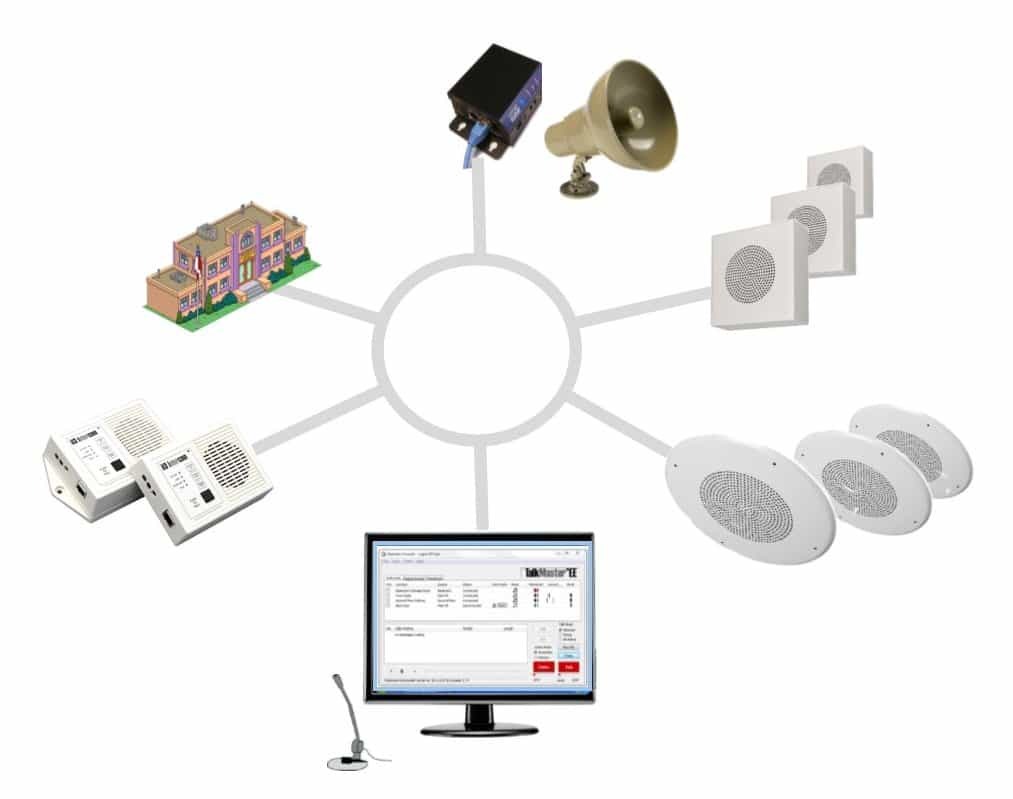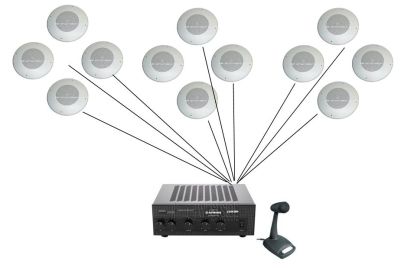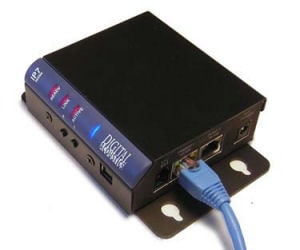
This article compares central analog amplifiers to distributed digital network attached amplifiers.
The latest IP paging systems utilize the Ethernet network to distribute sound over your organization. This is quite different than the classic systems that used a large central amplifier with wires to all the speakers. How good is this new approach to paging?
The following article compares the traditional approach that utilizes one large amplifier to the latest PA over IP systems.
The classic method of providing a paging system was to connect many speakers to a central very large amplifier. The latest IP amplifier method is much more flexible. It connects a few speakers to many small network attached amplifiers that are distributed around the organization. You can attach several speakers to one small IP amplifier or attach one CAT5 ready IP speaker directly to the network. Here’s a comparison the two types of systems.

Single Large Amplifier
The classic paging system used one large amplifier. The equipment cost for a large amplifier approach is less, but the installation cost is higher. For some people, the single amplifier solution is easier to operate because it doesn’t require a computer to make the page. Since it is a simple system, the single amplifier is not as flexible and provides fewer zoning options.
You can use an amplifier that has multiple channels, but then the system gets more complicated. Each amplifier channel can page the speakers in the zone selected using a switch setting. A zone could be a building, a floor or large area. This solution will not allow dynamic creation of paging zones, and provides less reliability. Since a single amplifier is used to power the paging system, failures could be more significant. For example, if the amplifier fails, the entire building (or large area) will no longer have paging. Because there is no end point monitoring of the amplifier, an amplifier failure will not be reported to the command center.
The labor cost of running the wires is a significant part of the installation. Many wire runs have to be made back to the central amplifier. This is much more time consuming than using the existing network infrastructure that’s already in place.
Network Attached Amplifiers
The latest approach utilizes a number of network attached amplifiers. This IP solution provides the ability to create unlimited zones and to create new zones as needed.
IP Intercoms can be added to the network just like the IP amplifiers. You can place intercoms in any room that you have a network drop available.

A network attached sound system allows you to customize and tailor the system to exactly what you need. In an emergency situation it may be advantageous to page to a specific floor or room, while not creating PANIC on the floor or in the building. Each IP speaker or group of speakers, because it has an assigned IP address, can be dynamically accessed or grouped to define a zone. This approach also provides higher reliability. The IP Amplifiers are associated with either an individual speaker or a small group of speakers. In the event of failure, only the speaker(s), associated with the IP amplifier module, will be affected. The remainder of the paging system will operate as usual. Because of health monitoring, if a module fails, the command center will be notified within 60 seconds of that failure, and repairs can be implemented.
A network attached sound system allows you to customize and tailor the system to exactly what you need. In an emergency situation it may be advantageous to page to a specific floor or room, while not creating PANIC on the floor or in the building. Each IP speaker or group of speakers, because it has an assigned IP address, can be dynamically accessed or grouped to define a zone. This approach also provides higher reliability. The IP Amplifiers are associated with either an individual speaker or a small group of speakers. In the event of failure, only the speaker(s), associated with the IP amplifier module, will be affected. The remainder of the paging system will operate as usual. Because of health monitoring, if a module fails, the command center will be notified within 60 seconds of that failure, and repairs can be implemented.
A page can be made from more than one location. A special Windows software application called Talkmaster is used to control where you send the pages. At the computer, you can use a microphone connected to the sound card to talk to the selected zones. If the computer that is normally used to make a page is not working for any reason the system automatically defaults to a backup computer, and if that one is also not working, you can select a 3rdbackup. This makes for a very robust and reliable system. You can also have more than one computer station or command center in use at the same time. For example, you can have one center at the administrative office of a university that makes general pages, and another center used by the campus police for emergencies. With additional SIP gateway software, you can also use a VoIP telephone (that’s SIP compatible) to make a page.
One of the most important features of these systems is that it is very simple to create paging across many buildings and locations. As long as you have a network connection, you can add multi-building paging.

Multi-building and multi-location pages can be made as long as all the locations are on the same network. You can even use the Internet to make pages to remote sites.
System Cost Comparison
For the purpose of this cost comparison we have assumed a labor cost of $100/hr. This labor cost can vary depending on where the work is done.
Network attached amplifiers can be placed very close to the speakers, and in some cases you can use a speaker that has the built in network attachment so much less wiring is required. Based on the number of wire runs required, let’s assume that it takes twice as long to install the centralized single amplifier system when compared to the network. Now this labor time can vary depending on how the building is constructed. It also assumes that there is an existing network infrastructure in place.
Let’s assume we would like to install a paging system in a single building. You would like to have paging in a number of small rooms, hallways and outdoor areas. Let’s assume that this building requires 100 speakers. Each speaker location may require different power and sound output, but to simplify this analysis let’s assume that each speaker requires an average of 2 watts each.
The single large amplifier requires an output power of at least 250 watts. We calculated that we require at least 100 x 2 watts = 200 watts at the speakers. We also need to have some overhead (overhead allows for loss in transformers and wiring) so let’s assume that the total power required from the amplifier is about 280 watts.
Since both systems require the same speakers I have left it out of the comparison.
Cost for Single Large Amplifier System
Single 280 watt amplifier = $900 (est)
Time to install 2 hours/speaker x 100 speakers = 200 hours x $100 = $20,000 labor cost.
Total cost is $20,900
Cost for Network Attached Amplifier System
A network amplifier costs about $365 (est.) and can provide 20 watts. You will require a number of these amplifiers to drive all the speakers.
280 watts / 20 watts/amp = 14 IP amplifiers x $365 = $5110
Time to install = 1 hour/speaker x 100 speakers = 100 hours x $100 = $10,000 labor cost.
Let’s assume that there are no open ports available on the existing network switches. In this case you may have to add small network switches in different locations that are accessible to where you want to place the IP amplifiers. Let’s assume you will need to add 7 switches at $100 each = $700.
Adding up all the components and the labor, the total cost is $15,810.
There is a savings of $5,090 or about 25% for the Network Attached System.
Conclusion
Network attached amplifiers have an advantage over the classic central paging system. Not only are they more flexible, reliable and provide more zone control, they are actually less costly. They have a significant advantage when you need to send a page to more than one building or even across the Internet to another part of the world.
To learn more and get help defining your network attached paging and intercom system, please contact us. We can be reached at 1-800-431-1658 in the USA, and at 914-944-3425 everywhere else. You can also use our contact form.